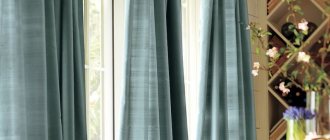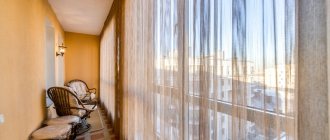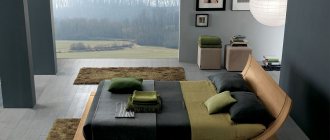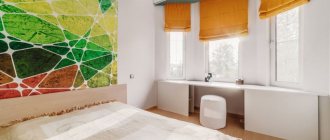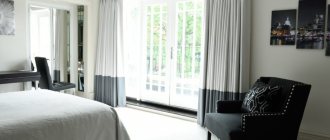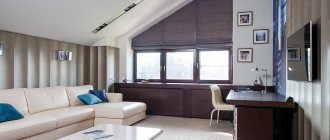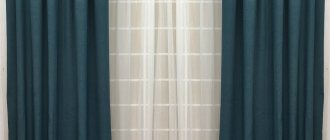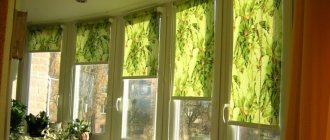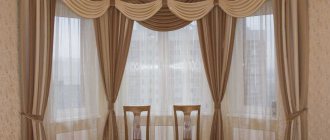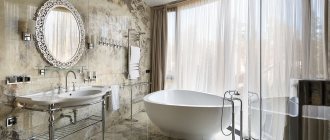Interior design features
There are a certain number of features:
- Linen has the ability to repel dirt, so curtains made from this fabric are perfect for decorating a kitchen.
- Linen curtains do not need lush drapery, as the texture of the material looks beautiful on its own. Therefore, you should not overload them with additional elements.
- Thick linen fabrics are more suitable for a bedroom or living room, where they will look expensive and stylish.
- The color of the curtains is selected in accordance with the main appearance and decor of the room.
Main characteristics of linen fabric
Eco-friendliness and practicality are just some of the important qualities. Linen curtains have an excellent appearance and fit into any type of interior. This fabric is produced fully or partially bleached, or no brighteners are used in production.
Often, companies that produce this material apply an interesting pattern to the fabric, or dye linen threads in different tones to ultimately get a checkered pattern, jacquard, stripes, or diamonds.
Advantages and disadvantages
Linen curtains have their advantages and disadvantages.
| pros | Minuses |
| Linen is an absolutely hypoallergenic material. Very durable. Such curtains require a fairly long service life. The fabric drapes well and holds its shape. Linen canvases are not electrified. This material has good thermoregulating properties. | The fabric may shrink after the first wash. This material cannot be bleached. For linen products, you need to carefully select washing products. It has a relatively high cost. |
Disadvantages of linen fabrics
This fabric wrinkles quickly and quite easily. Only if the manufacturer has added a little synthetics, flax “behaves” a little more prudently. The downside is that even after washing in cold water, the fabric will shrink. Therefore, when placing an order for new linen curtains at the studio, fabrics should be purchased with a reserve.
Another disadvantage is that over time and after a number of washes, the fabric becomes thinner and loses its original appearance. However, if you resort to the method of starching such curtains, you can significantly extend their life.
Note!
- Light green curtains - 120 photos of the most beautiful design and interior design options
- Ready-made curtains - how not to make a mistake with your choice? TOP 100 photos of the best new designs
Japanese curtains in the interior: bedrooms, kitchens, living rooms. 90 photos of the best new designs
Linen cannot be bleached at home, even if juice or coffee stains appear on the fabric. And another drawback is the rather high price of linen curtains.
Types of linen curtains
There are main types of linen curtains.
Curtains
They are a classic option. Linen curtains, with their neutrality, create a feeling of airiness, spaciousness and lightness in the room.
Roman
Linen Roman blinds on the window look light and gentle. They scatter light perfectly, do not collect dust and are quite easy to care for.
Blackout (imitation linen)
Blackout canvases, which do not transmit light, guarantee complete impermeability of sunlight into the room. They are not made from pure linen, but from special polyester fibers that create an imitation of texture close to natural fabric.
Curtains
Curtains made of linen voile have a unique texture and go well with a huge number of materials. Linen tulle is sometimes complemented with embroidery; during production, delicate shades act as the main colors.
Rolled
Day-night roller blinds made of linen allow even light into the room or allow you to create complete darkness in the room. Such designs look original.
Advantages and disadvantages of flax
When choosing any fabric, we first of all pay attention to its quality and properties. Even an amateur understands that wool cannot withstand high temperatures, and cotton wrinkles badly. Let's see what the pros and cons of flax are.
Linen perfectly allows heat and air to pass through, which is good for health. The material has high environmental qualities and does not cause any allergic reactions.
Flax fiber itself is very durable, which determines its long service life. Suffice it to recall how linen products, having experienced numerous washes, were passed on by inheritance, but at the same time retaining their presentable appearance. However, keep in mind that after washing, linen fabric shrinks by 7%. Therefore, when calculating the footage of curtains, buy textiles with a margin.
Pure linen fabric, without additives, wrinkles quite a lot. Perhaps this is the main disadvantage of natural flax. Each wash is not complete without long and thorough ironing of linen curtains to give them a flawless, smooth look.
Tip: it is better not to use aggressive detergents when washing linen curtains. Otherwise, the fabric may quickly become thin and lose its original attractiveness. To avoid stains, buy powders that do not contain chlorine.
Curtain sizes
There are no specific standards when choosing the length, so only the functional features of the window are taken into account here.
Short
Linen curtains, shortened to the window sill, of a simple cut, will look especially appropriate on a window near which a sofa, table or other interior items are located. They allow you to save space.
The photo shows the kitchen interior and short linen curtains on the windows.
Long
Particularly suitable for decorating living rooms, bedrooms or children's rooms. Such canvases look elegant and give the window opening a complete look. However, too long curtains lying on the floor get dirty very quickly.
Correct length
It is difficult to say what length is optimal for these curtains. For the kitchen, linen curtains or horizontal curtains up to the window sill are usually used. For living rooms, choose the length from floor to ceiling. You should not buy curtains 2 meters high, this length is not sufficient. Curtains must “rest” against some horizontal surface: window sill, table, radiator, floor.
Linen curtains should not be allowed to touch the floor or, worse, to trail along it. In this case, the curtains will look sloppy, ridiculous, and inappropriate. Simple linen fabric requires the same simplicity of design, so complications like this will only ruin everything.
Ideas in the interior of rooms and premises
Linen fabrics and design options for various rooms.
Kitchen
Light linen curtains, Roman or roller blinds, look especially stylish in the interior and go well with wooden kitchen furniture.
Living room or hall
Simple, discreet, but at the same time elegant long linen curtains will highlight all the advantages of the living room interior.
Bedroom
Natural linen, due to its positive qualities, is ideal for the bedroom. Also, to decorate this room, blackout curtains are used, which can reliably protect the room from the sun.
Children's room
Curtains made from such a safe and natural material are a classic option for children's rooms. Despite their simple appearance, they look quite interesting.
The photo shows a children's room and a window with pink linen curtains.
Balcony
Linen textured Roman or roller blinds are suitable for the balcony. In such a small room they will look especially organic.
Wooden house or cottage
Natural curtains are in perfect harmony with the overall appearance of the room and are combined with wooden wall cladding.
Terrace
Linen curtains create an atmosphere of comfort and warmth, allow air to pass through perfectly, flutter beautifully in the wind and generally correspond to the natural environment.
Types of fabrics
Depending on the purpose, linen fabrics are classified into the following types:
- Linen. They are used for sewing underwear and bedding. As a rule, the material is bleached.
- Towels. The fabrics are used for sewing towels.
- Dining rooms. Bleached or plain-dyed fabrics from which tablecloths and table napkins are sewn.
- Clothes. This material can be either plain or with a pattern on the surface. The fabric is used for making clothes. Things can be used both in summer and winter. In addition to feeling cool in hot weather, linen provides great warmth.
- Applied. Used for making small decorations (mainly for clothing).
- Decorative. This type of fabric is used for interior decoration. Decorative fabric is mainly used to make curtains, upholstery or pillowcases for decorative pillows.
There is also a classification according to weaving types:
- Twill.
- Linen.
- Large patterned.
- Finely patterned.
- Openwork.
- Satin.
Depending on the density of linen fabric and the method of weaving the threads, the material is divided into subtypes:
- Canvas. Used to make painting canvases.
- Tarpaulin and canvas. Used for sewing tents, raincoats and waterproof specialties. clothes. The material is woven from thick fibers and impregnated with special water-repellent compounds.
- Sackcloth. Bags are made from this coarse type of linen fabric, but the material is often used in decoration due to its special texture.
- Batiste. Lightweight material is intended for sewing clothes and sophisticated lingerie.
- Damask. A thick type of linen fabric that is used for sewing curtains and furniture upholstery.
- Crinoline. Thick lining fabric.
In addition to the above types, there are also kolomyanka, fine linen, ravenduc, matting and teak. All except the last one are mainly used for sewing clothes (from summer dresses to men's suits).
Visher flax is also found. This is a combined natural-synthetic material. It is almost 80% polyester, with the remainder being linen and spandex.
Examples in various styles
Curtains made of linen will also definitely find their place in various stylistic directions.
Provence
For this style, light monochromatic curtains or canvases decorated with flowers, embroidery, hemstitching, ruffles and lace trims would be appropriate.
Eco style
Here they give preference to natural materials. Thanks to their natural texture and thoughtful simplicity, linen curtains will be a win-win option for the interior of this format.
Classic
Linen curtains hold their shape well and create a clear silhouette, so in a classic interior they look truly elegant and discreet.
The photo shows a classic-style bedroom with linen curtains on the windows.
Modern (minimalism, loft)
Such styles do not require special decor. Linen fabrics of a simple cut can captivate with their luxurious naturalness and artlessness.
How to iron and starch?
Ironing linen curtains is a real test for the housewife. It requires a lot of effort and time.
First, hang dry the curtain. Immediately after washing, removing the curtains from the drum of the washing machine, simply hang the curtains on the curtain rod and leave for several hours until the fabric is slightly damp.
If you're lucky, the fabric will dry with virtually no wrinkles, making it fairly easy to iron.
Preheat the iron to maximum temperature. Iron the fabric until it is completely dry, moving gradually from the bottom edge of the curtain to the top. Remember that you should not steam linen curtains, as this still will not give any noticeable results. It's better to spend a little more time and iron them thoroughly. Curtains made from a mixture of linen and viscose will be especially “grateful”: wrinkled after ironing is quite a difficult task.
Usually linen curtains are already quite thick, but if the choice was made in favor of thin curtains, they need to be starched.
To treat curtains, you should use a medium-intensity solution, which is prepared as follows.
- A heaping tablespoon of starch should be diluted in a liter of warm water.
- Heat the solution, stirring, and wait until there are no lumps left. Boil.
- Then cool and dilute at the rate of 1 liter of solution per 10 liters of water. Rinse the curtains in a starch solution, wring them out and hang them to dry.
- Next, repeat all the same steps that were described for regular ironing.
Colors
Correctly selected colors and their combinations are the key to a harmonious and holistic interior of the room.
Grey
Aristocratic and elegant color. Adds a touch of sophistication and nobility to every interior.
Green
It is a symbol of nature, helps to create a comfortable and cozy environment and give the room a unique personality.
The photo shows a bedroom interior and a window with green linen curtains.
Beige
Soft and cozy. Curtains made of beige linen can advantageously emphasize and highlight bright details in the interior.
White
Milky color, like one of the shades of white, creates a calm atmosphere in the room and makes it simple and elegant at the same time.
Blue
Curtains of this color cool the interior and bring refreshing and invigorating colors to it.
Red
Bright and provocative. Red or its shade of burgundy attracts attention and allows the room to look like something from the illustrations of popular interior magazines.
Brown
Comfortable color, creates coziness, warmth and tranquility in the room. Particularly suitable for rooms intended for recreation.
Blue
It is considered an environmental color that is associated with the sea. It brings freshness and coolness to the room.
Yellow
Yellow canvases reflect light and expand the space. They refresh the appearance of the room, give positive emotions and improve mood.
The photo shows windows decorated with yellow linen curtains with drawstrings.
Turquoise
Fills the interior with romantic grace, creates a feeling of inspiration and a feeling of happiness.
Variety of color palette
Linen fabrics are given a wide variety of colors. However, more often there are muted tones: mustard, khaki, gray, olive, lilac, blue, beige, peach, cream, pearl. Delicate shades are universal and will suit any interior. Calm tones look great in a classic setting. In addition, linen fabric is considered non-marking, which significantly increases the period of use of curtains between washes. Quite often, natural canvas is decorated with drawings. Usually these are floral motifs and elegant script. Large prints, as well as bright contrasting shades, are also rare. Linen tulle is often decorated with embroidery that harmonizes with the pattern of the curtains. There are also two-color curtains, in which the shades are selected according to the principle of analogy. This option will help tie together the different colors used in the interior into a single composition.
Design and drawings
Curtain decorations are an important feature in setting the mood of a room.
With lace
Embroidery is a fairly common decoration for linen curtains. Lace gives the curtains a zest and uniqueness. Such paintings will look especially appropriate in rustic styles.
Geometry (stripe, check)
Curtains in large or small stripes, checkered, with diamonds or zigzags will perfectly complement any interior.
With flowers
Floral designs and ornaments will add sensuality and romanticism to the decor of the room.
The photo shows the living room and linen curtains with roses on the bay window.
Two-color
Combined two-color curtain solutions open up limitless window design possibilities.
With fringe
Fringe changes the appearance of curtains and makes it more impressive, flawless and seasoned. Curtains decorated with such a decorative element will definitely become the central accent of the entire interior.
Pros of linen curtains
Lightness, beauty, style, tenderness. In addition, linen is a breathable material. It allows air to easily pass through, so even when closed, such curtains will protect from the summer heat, but will keep the room cool. This fabric also has hypoallergenic properties; with proper care, it can maintain not only safety qualities, but also an impeccable appearance.
It is better to iron such curtains while still damp to avoid unsightly creases. Curtains for the living room, made from linen, are quite practical and versatile, as they are wear-resistant and do not transmit static electricity.
Curtain decor
Various accessories give the curtains a unique look and emphasize their style.
- Intercepted by bows. Linen curtains tied with bows instantly transform the room and make it homely and cozy.
- Lambrequins. They allow you to make the design of a room bright, spectacular and rather non-standard. Such designs look especially elegant on non-standard shaped windows, such as arches or bay windows.
- Pickups. They open up a lot of possibilities for configuring curtains.
- Hairpins. This decoration softens the contours of the window and gives it expressiveness and lightness.
- Fringe. Transforms the curtain design and is appropriate in a wide variety of styles.
The photo shows a living room in a modern style and linen curtains with tiebacks.
How to hang
Linen curtains are usually hung in two ways:
- On the eyelets.
- On the curtain tape.
The second option looks modest, but neat. If the window decor should be accentuated and eye-catching, then it is better to use stylish metal eyelets and the same cornice. It is not recommended to complement linen curtains with bandeaus or lambrequins, as this contradicts the concept of laconism, which is supported by the textured material.
Options for attaching to the cornice
There are several types of fastening:
- Eyelets. Such additional elements give the curtains style and chic.
- Loops. Using loops you can create an unusual curtain design.
- Rings. They are distinguished by great variety and are often used to decorate curtains. They give the curtains a finished and sophisticated look.
- Ties. Decorative bows and knots are a fairly common fastening option for light linen fabrics.
Subtleties of choice
The same linen curtains look completely different in the interior of different rooms. Linen fabric can be smooth or textured, very dense or thin and soft, based on this, the model and finish are selected. Let's look at some basic design tips.
Linen textiles mixed with lavsan and natural silk with a characteristic matte sheen or with the addition of silver or golden threads, despite the “folk” origin of the raw materials, give the premises an aristocratic chic. In the living room, the density of such fabric must be in harmony with other home textiles - upholstery on furniture, pillows, tablecloths. In the bedroom, linen curtains can be combined with bedspreads made of the same fabric.
Short, window-sill-length linen curtains in the kitchen are a classic of the genre. These can be ordinary towel curtains, cafe-style curtains, Roman lifting models (pictured above). If the room is decorated with natural materials, then against the background of ceramics, stone, and wood, curtains made of unbleached linen in combination with light cotton tulle will look very impressive and appropriate. The monotony of kitchen textiles can be enlivened by finishing with contrasting silk ribbons.
For children's rooms, it is recommended to use medium-density fabrics. Decorated with bright appliqué, light curtains will perfectly let fresh air into the room and protect from hot sun rays. If you want more shade, plant them on a bright, contrasting backing. To make it, it is better to use satin or cotton.
Finishing with lace, hemstitching or matching embroidery gives the curtains a special lightness and airiness. They look especially impressive in combination with linen tulle. This combination brings a feeling of freshness and cleanliness to the room.
Rarely woven tulle in combination with laconic thick floor-length curtains made of bleached linen looks strict and elegant. It can be used in any living space, but this combination is especially beneficial for the living room and bedroom.
Linen curtains are self-sufficient. They do not accept lush accessories, voluminous draperies and look ridiculous when combined with lambrequins. You should not pair them with partner curtains made of synthetic fabrics, even if they are curtains for the kitchen. The only thing they will tolerate next to them is curtains made of natural linen or cotton.
The choice of fastenings for linen curtains is unlimited. Hooks, curtain tape, drawstrings, patties, even loops made of jute rope will be appropriate for them, provided they match the interior. But especially from this variety I would like to highlight linen curtains with eyelets, as in the photo above. This option is a win-win, elegant, looking expensive and stylish in any setting.
Linen curtains go well with curtains, but not with all fabrics. If we talk about what kind of tulle to choose for a linen curtain, then it is best to choose natural fabric made from cotton fibers.
Recommendations for cleaning and care
If you follow the rules of care, linen curtains will last for more than one season. Such fabrics require regular dry cleaning using a vacuum cleaner with soft attachments.
How to wash linen curtains?
Step-by-step instructions on how and at what temperature to wash linen curtains:
- Load linen into the drum of the washing machine.
- Add a gentle detergent, without chlorine-containing impurities, since bleaching is strictly prohibited.
- Set the temperature to 40 degrees and start washing.
- After the process is completed. Curtains need to be shaken, straightened and hung to dry. Then slightly damp fabrics should be ironed at maximum iron temperature.
How to properly wash linen
It is recommended to do this no more often than once every couple of months. Choose detergents from a range of liquid, non-abrasive substances designed for delicate washing of light, delicate fabrics.
And no bleaches, otherwise unsightly stains will remain on the fabric. The optimal washing temperature is up to +40˚С. In an automatic washing machine, linen drapes and curtains should be washed separately, i.e. one curtain or drapery element at a time on delicate mode.
The mixed fabric will withstand temperatures of 60 degrees. Squeeze at 400-500 rpm, no more. Dry flat. It is necessary to iron such materials before they dry.
About flax: history, production and interesting facts
The discoverers of flax were the Indians.
Almost 10,000 years ago, linen was first made here. Gradually it replaced the “natural” material - animal skins. The plant began to be grown everywhere. Unique linen fabrics were woven in Ancient Egypt. Due to its incredible lightness, the fabric has been compared to “baby breath.” For clarity: 1 kg of yarn consisted of a thread approximately 240 km long. A modern ball of similar weight unwinds 30-40 km. The linen fabric turned out to be so thin and weightless that, folded in five layers, it was still slightly translucent. Any item of clothing could be passed through the ring. In Egypt, the loss of the harvest of this plant was considered a real disaster.
Linen items were highly valued in ancient times. The cost of the canvas was determined using scales. A thing was placed on one bowl, and gold according to its weight on the other. Only wealthy people, mainly priests, dressed in such clothes. Linen ribbons (bandages) were also used for mummification. They are perfectly preserved, as evidenced by the finds of Egyptologists. Some critics skeptically note that the bandages were soaked in balm, which “preserved” them, but linen fabric itself lasts a long time. It is believed that the secret of the “weightless” material has been irretrievably lost.
In Rome, linen was preferred by women. In Rus', plant cultivation began late - only at the beginning of the 11th century. The material was woven only for their own needs. Only by the middle of the 18th century did Catherine II give official permission to export fabric. In Europe, for a long time, linen was considered the preserve of wealthy families. Although the cost of fabric fell in comparison with Egyptian prices, it still remained high.
It was only after the Renaissance that even the poor could afford such things. Now flax is grown everywhere. In recent years, there has been a real boom in natural fabrics. Cotton, although lower in cost, clearly lost to flax in this competition. The point is the unique properties of hypoallergenic fabric, which is not only pleasant to the skin, but also treats burning, itching and other signs of irritation.
Special varieties of flax are used to make fabric. First, the plant is soaked, then dried and thoroughly crushed. The resulting blocks of raw flax are sent to the spinning mill, where they are made into threads.

